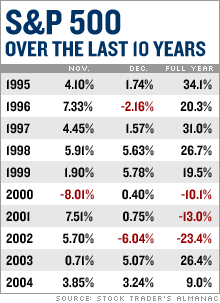 |
| Is a Santa Claus rally on tap? |
|
 |
|
|
|
|
|
|
|
|
|
|
NEW YORK (CNNMoney.com) -
Santa Claus arrived a bit early on Wall Street this week in the form of the Federal Reserve.
The signs that investors saw in the minutes from the Fed's Nov. 1 meeting -- hinting at a possible end to nearly a year-and-a-half of interest rate hikes -- are probably enough to temper most worries about whether an end-of-year run in is the cards, even after the market's stellar runup this month.
In the minutes, the Fed's policy-makers noted the risks of inflation but also the threat of possibly going "too far" in raising rates. They also mulled ways to temper their language in the future to prepare financial markets for an eventual pause, or end, to their rate-hiking campaign. (Full story.)
"I think the minutes added to the optimism that we may be near an end in the cycle," said John Davidson, president and CEO, PartnerRe Asset Management.
"That suggests that even after the stock advance we've already seen, there is some upside potential through the end of the year," he added.
But even before the release of the Fed minutes, the picture was looking decent.
The recent month-long rally has propelled stocks out of their recent range. Crude oil prices have apparently peaked, at least for now. Earnings have come in stronger than expected, and the economy seems to be thriving despite two massive hurricanes and a dozen straight rate hikes by the Fed -- in short, the "fundamentals" look good for the market right now, analysts say.
Then there's the seasonal factor -- this is the time of year when the market traditionally does best.
"Historically, the market has almost always been strong in this period through the end of the year," said Peter Brodie, director of investments at Bryn Mawr Trust Wealth Management.
"After the run we've had, I wouldn't be surprised if there was some consolidation in early December," Brodie said. "But a sell-off would then enable us to move higher" by year-end.
The 'Santa Claus' effect
December has been the best month for the S&P since 1950, according to the Stock Trader's Almanac, good for an average gain of 1.7 percent. It's the second best month for the Dow industrials, with an average rise of 1.8 percent over the same period.
December has been the second-best month for the Nasdaq since that market began in 1971. The Nasdaq composite, on average, gains 2.1 percent in the month.
The period is strong due to the impact of year-end dividends, bonuses and payouts. It's also strong because of the so-called "January effect," when the year's battered stocks bounce back once the tax-loss selling period is over. However, in recent years, the so-called January effect has been felt as early as November.
That's because Oct. 31 is the deadline for mutual fund managers and some big institutional investors to take losses for tax purposes each year. That tends to spark some October selling and push the year's biggest losers even lower, as managers seek to dump some of their worst performers.
After the tax-loss selling period is over, stocks tend to bounce back, an effect that often spills into the following year, therefore the January effect.
The effect also works in that, for individuals, the tax year ends Dec. 31, causing a similar bounce back for depressed smaller stocks. That's why small caps typically lead the charge in late December, according to the Almanac. Some analysts note that since smaller stocks have done so well this year -- the Russell 2000 index is currently trading just below all-time highs hit in August -- that the year-end rally may be muted.
Other supportive factors? The S&P has only fallen three Decembers over the past 15 post-election years; the fifth year of a decade hasn't been a downer in 120 years, and stocks usually rise in the first year after an election if an incumbent holds on to the White House.
On the downside, stocks slumped in January and April, which are bad omens for the market. A decline in the S&P 500 in January alone is enough to suggest a down year for the broader market, according to the Almanac. Add a down April and the outlook only gets worse.
Year-to-date, the S&P 500 is up 4 percent.
Already here and gone?
Despite the positives, some analysts say the market may have already seen its year-end rally. The five-week advance has put the Nasdaq and S&P 500 at nearly 4-1/2 year highs and the Dow at an eight-month high.
"I'm not expecting a sell-off, but it's possible that we've seen the top for this year," said Stephen Leeb, president at Leeb Capital Management, noting the recent advance coincided with the drop in oil prices, a stimulus unlikely to persist in coming weeks.
"Once that supportive factor backs out, I think the market is going to have trouble making much progress," Leeb said.
Other headwinds include the impact of higher rates and an expected slowdown in economic growth in 2006.
There's also the question of the consumer. Worries about a spending slowdown grew after the first of two massive hurricanes hit the Gulf Coast in late August, sending crude oil above $70 a barrel and gasoline above $3 a gallon, albiet briefly.
These factors added to worries about the critical holiday shopping period and the strength of economic growth. Consumer spending fuels roughly two-thirds of the economy.
Recent evidence has suggested that spending will come under more pressure next year due in part to a slowing housing market that will cut into consumers' refi "pocket money."
Yet the 2005 holiday season still could be surprisingly decent.
No. 1 retailer Wal-Mart is forecasting a strong season, and the National Retail Federation on Tuesday boosted its holiday sales forecast to a 6 percent increase, from 5 percent, due in large part to the retreat in gas prices.
"Investors have had low expectations for the holiday shopping season," PartnerRe's Davidson said. "If it turns out to be stronger, you get the positive surprise factor."
Stocks could also benefit from the much-discussed resiliency of the market.
"There have been enough negatives that you'd think it would have been a good year for stocks to take a pounding, but that hasn't happened," said Ram Kolluri, chief investment officer at GlobalValue Investors.
"I think that momentum is still in place and should sustain us through the end of the year."

|